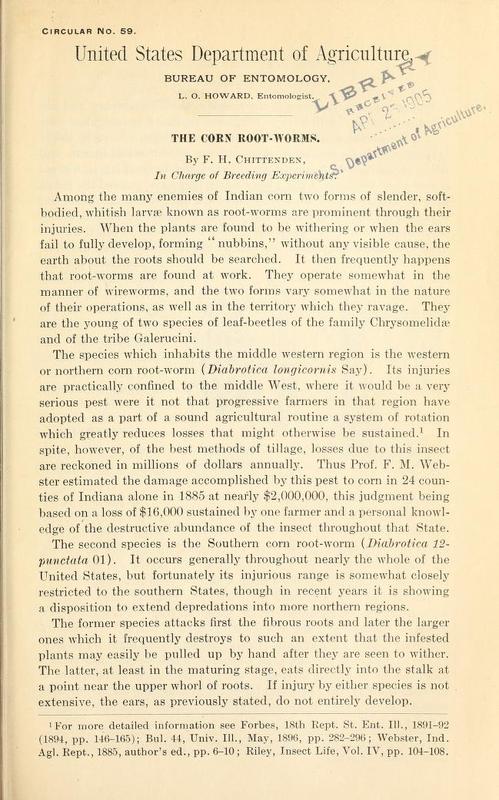The Corn Root-Worms
Creator
Date
1905
Subject
Excerpt
The second species is the Southern corn root-worm (Diabrotica 12 punctata 01). It occurs generally throughout nearly the whole of the United States, but fortunately its injurious range is somewhat closely restricted to the southern States, though in recent years it is showing a disposition to extend depredations into more northern regions.
The former species attacks first the fibrous roots and later the larger ones which it frequently destroys to such an extent that the infested plants may easily be pulled up by hand after they are seen to wither. The latter, at least in the maturing stage, eats directly into the stalk at a point near the upper whorl of roots. If injury by either species is not extensive, the ears, as previously stated, do not entirely develop.
This species is also known in the South as the "bud-worm" and less commonly as the "drill worm." In some regions it is recognized only by the former name, while the latter is of more recent use. The beetle is familiar to most persons in its occurrence on cucumber, squash, and other cucurbits. It frequents the flowers, and by peeping into them one or more beetles and the places where they have gnawed the petals may be seen, for they are among the most omnivorous of insects and appear to be able to subsist on any form of vegetation on which they may happen to alight. They are, in fact, to be found in practically all fields of corn and in gardens everywhere, but it is seldom that the larvae associated with the beetles except by those well versed in entomology or who have had experience with both forms of insects. The species is best known northward as the twelve-spotted cucumber beetle.
This insect has four stages, adult or beetle, egg, larva, and pupa.
The former species attacks first the fibrous roots and later the larger ones which it frequently destroys to such an extent that the infested plants may easily be pulled up by hand after they are seen to wither. The latter, at least in the maturing stage, eats directly into the stalk at a point near the upper whorl of roots. If injury by either species is not extensive, the ears, as previously stated, do not entirely develop.
This species is also known in the South as the "bud-worm" and less commonly as the "drill worm." In some regions it is recognized only by the former name, while the latter is of more recent use. The beetle is familiar to most persons in its occurrence on cucumber, squash, and other cucurbits. It frequents the flowers, and by peeping into them one or more beetles and the places where they have gnawed the petals may be seen, for they are among the most omnivorous of insects and appear to be able to subsist on any form of vegetation on which they may happen to alight. They are, in fact, to be found in practically all fields of corn and in gardens everywhere, but it is seldom that the larvae associated with the beetles except by those well versed in entomology or who have had experience with both forms of insects. The species is best known northward as the twelve-spotted cucumber beetle.
This insect has four stages, adult or beetle, egg, larva, and pupa.
Title
The Corn Root-Worms
File(s)
Corn Root-Worms 1.jpg
(image/jpeg)
Southern Corn Root-Worm.jpg
(image/jpeg)
Corn-Root Worm.jpg
(image/jpeg)
Corn Root-Worms 2.jpg
(image/jpeg)
Corn Root-Worms 3.jpg
(image/jpeg)
Corn Root-Worms 4.jpg
(image/jpeg)
Corn Root-Worms 5.jpg
(image/jpeg)
Corn Root-Worms 6.jpg
(image/jpeg)
Corn Root-Worms 7.jpg
(image/jpeg)
Corn Root-Worms 8.jpg
(image/jpeg)
 An official website of the United States government.
An official website of the United States government.











